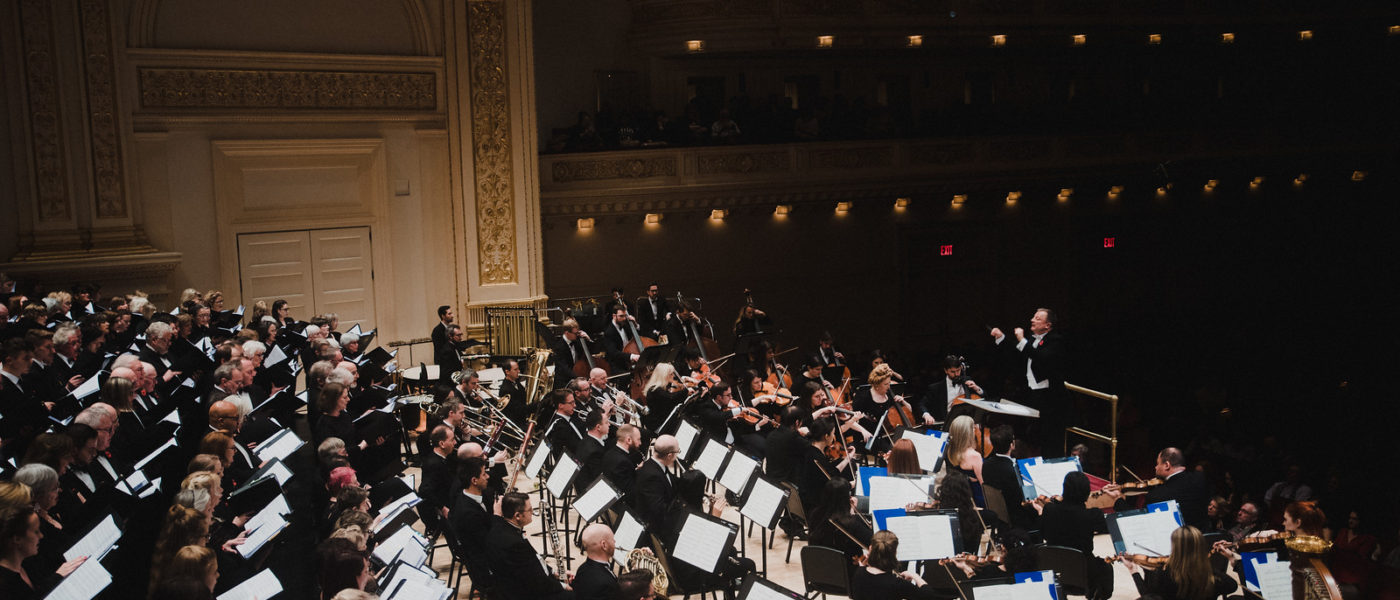Distinguished Concerts International New York (DCINY) presents The Great War: Commemorating 100 Years in Review
Distinguished Concerts Orchestra; Distinguished Concerts Singers International
Patrick Hawes, composer/conductor
Paul Mealor, composer/conductor
Diana McVey, soprano; Scott Joiner, tenor
Stern Auditorium at Carnegie Hall, New York, NY
November 11, 2018
On the 11th hour of the 11th day of the 11th month in 1918, the guns that had raged for four years fell silent. The Great War (what we later called World War One) was over. One hundred years later commemorations of those millions of lives lost take place in ceremonies throughout the world. At Carnegie Hall in New York City, Distinguished Concerts International New York (DCINY) presented a concert entitled The Great War: Commemorating 100 Years, featuring two United States premieres, Patrick Hawes’ The Great War Symphony and Paul Mealor’s Requiem: The Souls of the Righteous. It was a meaningful way to pay tribute to the memories of the fallen during this centennial anniversary.
The Distinguished Concerts Singers International had choruses hailing from Connecticut, Kansas, New Mexico, New York, Texas, Wisconsin, Australia, Canada, Germany, Hong Kong, United Kingdom, and “individual singers from around the globe.” Soloists Diana McVey (www.dianamcvey.com) and Scott Joiner (www.scottjoinertenor.com), both DCINY favorites, were present to lend their considerable talents.
Patrick Hawes (www.patrickhawes.com) took the podium to conduct the United States Premiere (Joint) of The Great War Symphony. Each movement covers one year of the war: I. Praeludium (1914-1915), II. March (1915-1916), III. Elegy (1916-1917), and IV. Finale (1917-1918). The conception is highly programmatic. The calm before the storm and steadfastness of duty of the first movement gives way to the horrors of battle in the second and to the disillusionment and despair of the third movement. The fourth and last movement expresses the final year of fighting, the silencing of the guns, and the heartache of paying tribute to those countless lives lost – with resolution never to forget the sacrifices. The Great War Symphony has a decidedly British (and Commonwealth) focus. One can hear the influences of the great British Composers (most notably Elgar, Holst, and Vaughan Williams) throughout. This is not at all surprising considering the origin of the commission in the United Kingdom and the fact that the losses were closer to home and more extensive in Britain than in the United States (where the history of World War One is often taught something like this: Archduke Franz Ferdinand is assassinated, Europe goes to war, things bog down into trench warfare where neither side makes any progress, then the United States gets involved after the Lusitania is sunk -after waiting two years! – and suddenly it’s all over).
The texts were chosen with care, and Mr. Hawes provided good program notes that I hope will be available at the DCINY website, as they have usually posted programs in past concerts. Check this link : DCINY The Great War: Commemorating 100 Years.
At the beginning of the third movement, concertmaster Jorge Ávila played a violin that belonged to Herbert Simmons, who was killed in action at the Somme in 1916. “Uncle Bertie,” as he was called by his family, was an amateur violinist who dreamed of becoming a professional musician. His brother Lawrence kept the violin to remember him, and each generation that followed learned to play on it. The family allowed the violin to be brought to New York to be used in this performance.
Tenor Scott Joiner has a strong voice that can fill any hall. While his lyric gifts were abundantly displayed, it was his bitingly ironic tone in “The Song of the Mud” from the third movement that this listener enjoyed the most. Soprano Diana McVey sang with a poignant beauty as she gave voice to the heartache of mothers. daughters, wives and fiancées, not to mention the women who witnesses events first-hand.
The Great War Symphony is a work by a composer of craft and skill. It does not descend into sentimental tripe nor does it explode into cheap “war” bombast. This listener was engaged for the hour-long duration and thought, given the programmatic aspect, that adding a visual component (such as a projection of pictures from the war) would heighten the experience for many listeners, especially those with no real knowledge of World War One.
The chorus was well-prepared, with good balance and clear diction throughout, and the orchestra played with intense focus and energy. The audience gave Mr. Hawes a standing ovation for his fine work.
After intermission, Paul Mealor (www.paulmealor.com) took the stage to conduct the United States premiere of his Requiem: The Souls of the Righteous. This forty-minute, ten-movement work uses sections of the traditional Requiem mass with scripture from the King James Bible, and poems from Grahame Davis.
My colleague Frank Daykin wrote in an earlier review of Mr. Mealor that “if there ‘is’ a heaven, I want it to sound like the music of Paul Mealor.” One tends to understand why when listening to his Requiem – Mr. Mealor’s God is unfailingly compassionate, His judgment of souls is heavily tilted towards mercy, and all souls are worthy of Heaven. This work is filled with serene beauty from start to finish – even Fauré’s Requiem sounds fearsome in comparison!
There were numerous soloists (uncredited) from the chorus, all who did well in their featured roles, but special mention goes to one tenor, a very tall young man, who really filled the hall with his strong voice. The chorus was lovely, but one has to acknowledge that while they did excellent work, the “heavy lifting” was already done by the composer. The string orchestra was perfection in balance and ensemble.
The use of tuned wine glasses in the final movement (Lux aeterna: And let there be a Heaven) provided an ethereal effect that was enchanting. When the very last vibrations of the wine glasses slowly died away, one could feel the entire audience holding their breath as one. Then a loud and extended standing ovation followed, richly deserved.

